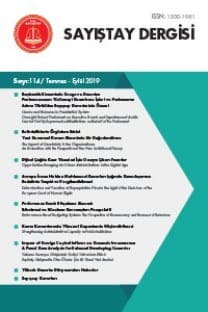AFET RİSKLERİNİ AZALTMAK - SAYIŞTAYLARIN ROLÜ
Bu çalışmanın amacı, Sayıştayların afet risk ve zararlarını azaltmaya yönelik faaliyetleri nasıl denetlemesi gerektiğine ilişkin özgün bir perspektif ve yaklaşım oluşturulmasıdır. Bu çerçevede, konunun uluslararası toplum tarafından ele alınış yöntemi ve yeni yönelimler, parlamento ve hükümetlerin politika üretme ve uygulamaya ilişkin sorumlulukları ile bu sorumlulukları yerine getirirken diğer kurum ve kuruluşlarla etkileşimleri ele alınmıştır. Makalede temel olarak, afet risk ve zararlarını azaltma faaliyetlerinin daha iyi yönetilmesine ilişkin dünya Sayıştaylarının katkı verme biçimleri, denetim tür, yöntem ve yaklaşımları irdelenerek, Sayıştayların bu alana ilişkin denetimlerini nasıl tasarlamaları gerektiğine ilişkin bir çerçeve oluşturulmaya çalışılmıştır. Ayrıca, bu alandauluslararasıve bölgesel işbirliklerinin geliştirilmesinin önemine vurgu yapılmıştır. Konu bütün bu yönleriyle irdelenirken, gerek politika üretiminde gerekse faaliyetleri planlamada, afet kavramına ilişkin bir algı sapmasının başarıyı ve köklü çözümleri önleyen etkisine dikkat çekilmiştir. Vatandaşa karşı sorumlulukları kapsamında Sayıştayların, soruna nasıl katkı verebilecekleri tartışılarak, denetim yaklaşım ve yöntemlerini de içeren öneriler geliştirilmiştir. Afet risk ve zararlarının azaltılmasına yönelik faaliyetlerin nasıl denetleneceğine ve denetimde nelere odaklanılacağı konusuna özgün bir perspektif getiren bu çalışmanın, temel olarak yüksek denetim örgütleri ve iç denetim birimlerinin denetim faaliyetlerinin geliştirilmesine katkı sağlaması beklenmektedir. Ayrıca, gelecekteki akademik çalışmalara, uygulamacı birimler ve sivil toplum kuruluşlarının çalışmalarına da ışık tutacağı düşünülmektedir. Kuşkusuz, hesap verme sorumluluğu çerçevesinde, parlamentoların ve vatandaşların dikkatinin bu alanda odaklanılması gereken hususlara çekilmesi, olası en büyük katkı olacaktır.
REDUCING DISASTER RISKS-THE ROLE OF SAIs
This study aims at formulating an original perspective and approach regarding how SAIs should audit disaster risk and hazard reduction activities. Within this context, it addresses the methods and new approaches adopted by the international community, the responsibilities of the Parliament and governments to generate and implement policies in the area as well as their interactions with other institutions and organizations in discharging this responsibility. This study mainly looks into how SAIs add value to the better management of disaster risk and hazard reduction activities as well as their audit types, methods and approaches, and tries to establish a framework regarding how SAIs should design their audits in this specific area. The significance of international and regional collaboration is also highlighted. While elaborating on the issue from all these aspects, this study points out the fact that a misperception related to the concept of disaster adversely affect the success as well as the generation of radical solutions both in policy-making and planning of these activities. How SAIs can contribute to the area in line with their responsibility against the public is discussed and recommendations covering also the audit approaches and methods are developed. This study, which introduces a specific perspective regarding how SAIs should audit disaster risk and hazard reduction activities and the areas of focus in the audit, is expected to contribute primarily in the development of the audit activities of supreme audit institutions and internal audit units. Furthermore, it is considered that this study will also guide the future academic studies as well as the works of implementing units and the NGOs. It is beyond doubt that within the framework of accountability, drawing the attention of Parliaments and the public to the issues of concern in this area will be the greatest possible contribution.
___
- Demirbaş, Tolga (2001), "Sayıştaylar Tarafından Gerçekleştirilen Performans Denetimleri ve Türk Sayıştayı Uygulaması", Sayıştay Başkanlığı Yayınları, Araştırma, İnceleme, Çeviri dizisi:17, Ankara.
- Inter-Parliamentary Union (IPU) & UNISDR (2010), Disaster Risk Reduction: An Instrument for Achieving the Millennium Development Goals, Advocacy Kit for Parliamentarians, http://www.unisdr.org/files/15711_parliamentariankitfinal.pdf.
- INTOSAI (2004) , "Implementing Guidelines for Performance Auditing, ISSAI 3000" http:// www. issai.org/media(879,1033)/ISSAI_3000_E.pdf (07.12.2012).
- INTOSAI (2008), http://eca.europa.eu/portal/page/portal/intosai- aada.
- INTOSAI (2012), " The Draft Exposure Draft ISSAI 5510 Audit of Disaster Preparedness: Guidance for Supreme Audit Institutions", http://www.issai.org/composite-280. htm (20.11.2012).
- İstanbul İl Afet ve Acil Durum Müdürlüğü (2012), "Birey ve Aile için Depremde İlk 72 Saat" http://www.guvenliyasam.org/yayinlar/birey-ve-aile-icin-depremde-ilk-72-saat (04.12. 2012).
- Kadıoğlu, Mikdat (2011), http://nefius.com/news/1671311.2 (05.12. 2012).
- Munich Re NatCatSERVICE, http://www.preventionweb.net/files/24476_20120104munichr enatural catastrophes[1].pdf, (Kasım 2012).
- Rego, Alosius J (2001), "National Disaster Management Information Systems & Networks: An Asian Overview", http://www.adpc.net/v2007/ikm/ONLINE%20DOCUMENTS/ downloads / Paper AtGdin01.pdf (21.11.2012).
- Sayıştay Başkanlığı (2002a), Performans Denetimi Raporu, Bayındırlık ve İskan Bakanlığının Marmara ve Düzce Depremleri Sonrası Faaliyetleri http://www.sayistay.gov.tr/rapor/ perdenrap/2002/2002-3deprem/marmaradep.pdf (23.11.2012).
- Sayıştay Başkanlığı (2002b), Performans Denetimi Raporu, İstanbul Depreme Nasıl Hazırlanıyor? http://www.sayistay.gov.tr/rapor/perdenrap/2002/2002-2istdeprem/ 2002-2istdeprap.pdf, (13.11.2012).
- UN (1994a) Yokohama Strategy and Plan of Action for a Safer World, Guidelines for Natural Disaster Prevention, Preparedness and Mitigation, World Conference on Natural Disaster Reduction, Yokohama, Japan, 23-27 May 1994, http://www.un.org/ documents/ecosoc/res/1994 /eres1994-31.htm, (12.11.2012).
- UN (1994b), Economic and Social Council, 1994/31. International Decade for Natural Disaster Reduction, http://www.un.org/documents/ecosoc/res/1994/eres1994-31. htm, (12.11.2012).
- UN (2005), World Conference on Disaster Reduction in Kobe, Hyogo http://www.unisdr. org/2005/wcdr/wcdr-index.htm, (12.11.2012).
- UN (2007), Hyogo Framework for Action 2005-2015: Building the Resilience of Nations and Communities to Disaster, http:// www.unisdr.org/hfa , (07.12. 2012).
- UN (2009), "UNISDR Terminology on Disaster Risk Reduction," http://www.unisdr.org/we/ inform /terminology, (15.11.2012).
- UN (2011a), Hyogo Framework for Action 2005-2015: Building the Resilience of Nations and Communities to Disaster, MID-TERM REVIEW, 2012-2011.
- UN (2011b), The 21st UN/INTOSAI Symposium-2011, the Theme: "Effective Practices of Cooperation Between SAIs and Citizens to Enhance Public Accountability", http:// www.unpan.org/2011UN-INTOSAI-Symposium (15.11.2012).
- UN (2011c), GAR 2011, Global Assessment report on Disaster Risk Reduction, Revealing Risk, Redefining development.
- UN (2012), " General Assembly Adopted Resolution A/66/209", http://www.eurosai.org/ docs/ 2012/UN_Resolution.pdf (15.11.2012).
- UNISDR (2012), " My City is Getting Ready, 2010-2011 World Disaster Reduction Campaign" http://www.unisdr.org/campaign/resilientcities (05.11.2012).
- Ütük, Seher Özer (2011), "21. BM/INTOSAI Sempozyumu: Kamuda Hesap Verebilirliğin Geliştirilmesi için Sayıştay ve Vatandaşlar Arasında Etkin İşbirliği, (çeviri, http://www. unpan.org /2011UN-INTOSAI-Symposium )" (Sayıştay Dergisi, Sayı 82).
- ISSN: 1300-1981
- Yayın Aralığı: Yılda 4 Sayı
- Başlangıç: 1990
- Yayıncı: T.C. Sayıştay Başkanlığı
Sayıdaki Diğer Makaleler
KAMUDA STRATEJİK PLANLAMAYA DAYALI PERFORMANS YÖNETİMİ: TÜRKİYE UYGULAMASI VE SORUNLAR
YENİ KAMU MALİ YÖNETİM VE DENETİM SİSTEMİ ÇERÇEVESİNDE SAYIŞTAYIN ROLÜ
AFET RİSKLERİNİ AZALTMAK - SAYIŞTAYLARIN ROLÜ
Arife COŞKUN, Levent KARABEYLİ
SAHTECİLİK VE YOLSUZLUKLA MÜCADELEDE SAYIŞTAYLARIN ROLÜ: ASOSAI 2012 FİLİPİNLER ÇALIŞTAYI
